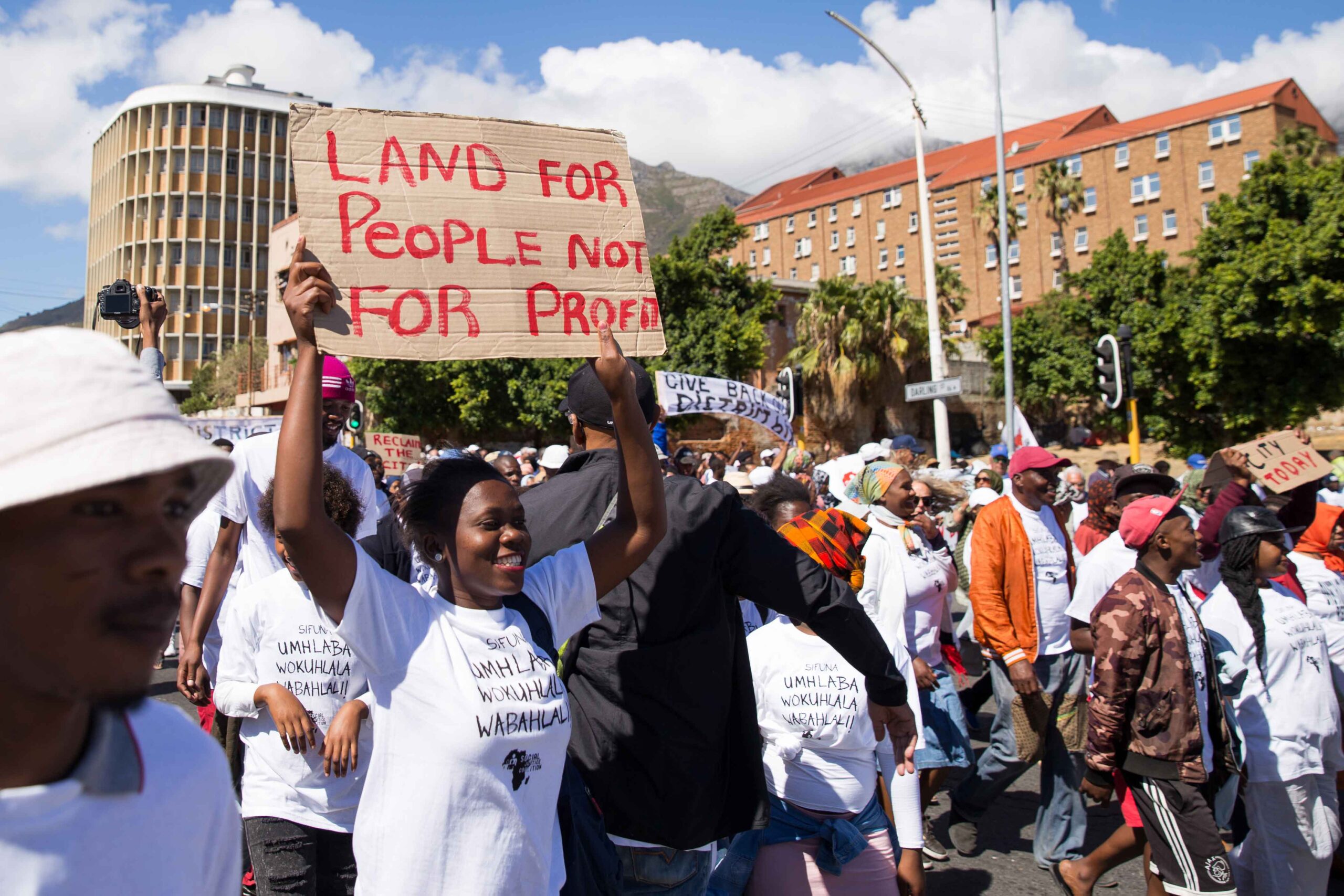The South African government owns large amounts of vacant land, much of it in areas where affordable housing would enable economic inclusion of poor and marginalised communities. However, the release and development of this land has been extremely slow. In partnership with experts on property and land development in South Africa, the HSRC’s Ivan Turok presents a step-by-step plan to aid stakeholders in accelerating access to affordable housing in well-located urban areas. Jessie-Lee Smith summarises the main recommendations.

Thousands of people marched towards the Cape Town Civic Centre on Human Rights Day in March 2018 to demand land for better housing. The need for affordable housing in well-located urban areas remains urgent. Photo: Ashraf Hendricks/GroundUp
The legacy of apartheid includes persistent housing shortages, as well as ruinous spatial marginalisation of poor communities from economic and social opportunities. Meanwhile, the public sector retains sizeable amounts of vacant and underused land, some in well-located parts of cities with good access to jobs and social amenities. This land is a valuable resource which, through affordable housing, could help address the chronic shortage of such accommodation in desirable locations and counteract the typically exclusionary character of the property market in many urban areas of South Africa.
The government’s social housing programme has attempted to promote affordable accommodation on prime public land, to encourage integration and upward mobility. Municipalities are required to designate restructuring zones for these projects. However, the misplaced assumption that public entities would readily offer their surplus land at reduced prices, coupled with excessive red tape designed to prevent fraud and corruption, has meant that the programme has not achieved its transformative potential, resulting in underspent budgets and little impact on urban inclusion.
In response to the need to accelerate the release of public land for affordable housing, the HSRC’s Prof. Ivan Turok and a team of partners and property experts investigated the underlying problems. They have written a report based on four case studies of major cities, including Johannesburg, Cape Town, eThekwini (Durban) and Tshwane (Pretoria). The report presents steps to assist stakeholders, including government bodies, private partners, and non-profit developers, in mitigating procedural errors, excessive delays and opaque rules governing the release of public land.
These legal and bureaucratic complexities have often confounded planned projects using public land, which emphasises the importance of simplifying and streamlining procedures. Understanding the seven essential steps in the process, which are outlined below, is crucial.
1. Land identification
Identifying suitable land is the first step in the process of public land release and development. The government’s land portfolios should be meticulously combed through to identify sites that are most suitable for affordable housing. Suitable ‘raw’ land parcels should be identified by their location in relation to economic opportunities, access to transportation, and public amenities. Parcels should not contain costly physical constraints to development, such as steep slopes, poor drainage, or contamination. Groups of adjacent land parcels are ideal, because they facilitate neighbourhood planning processes and allow supporting investments, such as public spaces, to be more easily coordinated.
2. Land reservation
Municipalities then need to reserve the land for affordable housing. Reserving land stops it from being used for other purposes, as officials would then turn down requests to use the land in other ways. Various stakeholders need to be consulted and included in the process at this stage. For example, politicians have specific mandates and may contest the lost revenue from subsidised disposals. The local community also may have reservations about land earmarked for low- or middle-income housing. Arrangements may also need to be made to protect the site from unauthorised occupation.
3. Land packaging
Reserved land now needs to be ‘packaged’ for development. Land packaging adds value to a parcel and, when no shortcuts are taken in legal procedures, can significantly improve prospects of the site being developed. Packaging land involves creating a design of what will be built, including specifications such as scale, density, composition and layout. These concept plans should be expertly drafted after engineering studies of the site, analyses of market demand, feasibility assessments, financial modelling, and due diligence investigations of legal matters. At this stage, a land parcel would also undergo several processes to ensure its viability. The land should be valued, it should be rezoned if necessary, and should undergo environmental and heritage studies. Again, stakeholders should be involved in this process to ensure the plan creates value for all concerned and reduces risks and uncertainties for developers.
4. Consultation
Once packaged, internal and external consultation is required to handle objections, make any amendments to the concept plan, and confirm its validity, viability and legitimacy. Various stakeholders, including several municipal departments and politicians, must formally approve these plans. Given the material and symbolic value of land, engaging the local community is important in order to respond to their needs and fears, benefit from their knowledge, and obtain their buy-in. Failure to communicate and consult with stakeholders can risk court disputes, delays and even physical disruptions.
5. Disposal method
Packaged land is then disposed of by the government, which means it is sold, exchanged, donated, or leased. One way of doing this is by a public tender where developers bid competitively for the opportunity. This method requires very clear and transparent criteria explaining how the quality of the bids will be assessed. Alternatively, municipalities may come to more of a negotiated arrangement for highly complex projects, involving experienced developers that they can trust to deliver a successful outcome. This method saves much of the preparatory work and is also appropriate when developers are inexperienced and require capacity building for their projects to be viable.
6. Legal agreements
Legal agreements are essential for the transparent release and development of government land. These agreements safeguard the public good and help protect the project from failing to meet its objectives, by specifying the responsibilities of both parties. Both the municipality and the developer sign an agreement that spells out conditions attached to the sale or lease of the land.
7. Land development
Once land has been transferred to a developer, physical construction can take place. This includes the development of internal roads, utilities and other infrastructure. The actual buildings typically come next, followed by further improvements to the site, such as landscaping. Developers face many risks and vulnerabilities during this process, including changes in market conditions or the price of inputs that affect project viability. These risks can delay construction or require renegotiated arrangements with key stakeholders.
The tasks covered by this report’s step-by-step approach include all stakeholders who would and should be involved in the process. Government bodies, private partners, and non-profit developers can utilise the steps presented to make the release and development of land more efficient and successful. If followed alongside the range of laws, regulations and policies that govern the release of municipal land for affordable housing, these steps could help accelerate the economic inclusion of marginalised communities.
Research contact:
Prof. Ivan Turok, a distinguished research fellow in the Equitable Education and Economies Division of the HSRC, and the DSI/NRF Chair in City-Region Economies at the University of the Free State
iturok@hsrc.ac.za


